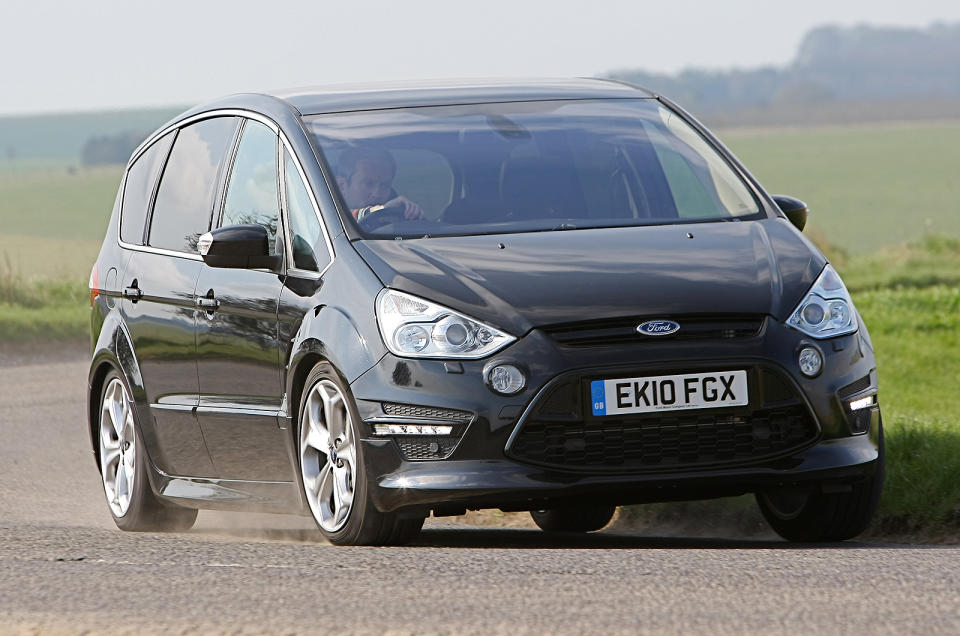Used Ford S-Max 2006-2014 review

The Ford S-Max 2.5T of 2006 to 2009 was the Clark Kent of motoring.
A comic-book hero that doubled as a sober-suited executive MPV during the week and responsible family holdall at weekends, but which, thanks to the 217bhp 2.5-litre five-cylinder turbocharged petrol engine from the contemporary Focus ST under its bonnet, could morph into a hot hatch-baiter capable of 0-62mph in 7.4sec.
Today it’s extremely rare, although it is still possible to find well-maintained examples. More commonplace, and nearly as much fun, is its successor of 2012, powered by a 2.0T Ecoboost petrol engine making 237bhp.
This version cracks the benchmark sprint in a shade under eight seconds, and it would be quicker but is paired with an automatic gearbox, whereas the 2.5T version enjoyed a six-speed manual. Both too much for your heart and your pocket?
Then seek out the more plentiful 200bhp 2.0T from 2010 that takes half a second longer and drinks a little less fuel. Whichever version you choose, they are impressive figures for a seven-seat family car.
Incidentally, we’re talking about the first-generation S-Max, launched in 2006, updated in 2010 and replaced in 2015 by the second. The latter is sleeker-looking and sports a lot more technology, but this publication's testers preferred the first-gen’s ride, handling and steering.
The model was voted European Car of the Year in 2007, and there’s plenty more to celebrate. Those potent petrol engines were offered alongside a range of diesels. Among the latter, our favourite is the 161bhp 2.0 TDCi, especially combined with the Powershift dual-clutch automatic gearbox.
Thanks to the engine’s wide spread of torque, you should see around 50mpg with moderate driving. From 2010, petrol and diesel engines were either replaced or updated, but don’t expect to drive one of the diesels into a ULEZ area scot-free. At best they are Euro 5-compliant – Euro 6 is required – so they will attract a charge.
Also as part of the 2010 update, Ford improved the S-Max’s ride and handling – not that the engineers had to burn too much midnight oil, because beneath that capacious body is the chassis of our favourite repmobile, the Ford Mondeo.
We describe the S-Max as a seven-seater, although Ford called it a 5+2 – an acknowledgement that the rearmost seats are big enough only for children. There’s not much head room, either, owing to the S-Max’s raked roofline – but it’s one reason why people bought it over the more upright Galaxy. Those seats and the middle row fold into the floor to give a 2m-long load bay.
Trim levels rise through Zetec and Titanium to Titanium X Sport. This last adds a sports bodykit, twin chrome-tipped exhausts and – don’t laugh – a rear diffuser. In this spec, and with either the 163bhp 2.0 TDCi under the bonnet or the punchy but reasonably efficient 200bhp 2.0T, a post-2010-reg S-Max looks a proper eyeful.
Diesels outnumber petrols and Titanium trim is the most plentiful; sports suspension was an option. It firms up the ride, which, fortunately, remains comfortable.
When Autocar tested the S-Max, our testers saved their biggest accolade for the verdict, stating simply: “The car is comfortable and secure yet can also put a smile on your face.” We’ll take that.
Ford S-Max (2006-2014) common problems
Engine and gearbox: Given how many have been sold, you can expect all sorts of horror stories. The best you can do is insist on a full service history, ideally from a Ford dealer, with invoices detailing every job. Fresh oil, both engine and transmission, plugs, coolant and brake fluid at the right intervals are essential. On low-mileage cars or cars that have spent a long time in the city doing stop-start driving, be aware of issues with the dual-mass flywheel.
Electrics: Many issues with the S-Max concern the electrical system and features, so check for things such as warning lights and failed parking sensors. There have been reports of blocked drain channels flooding the wiring loom and of water ingress into the wiper arms and alarm module.
Brakes and suspension: Expect the suspension to have suffered a hard life and be feeling a little tired. Don’t rely solely on the handbrake on a steep slope, either – engage gear to be on the safe side.
Interior: Being a family car, the S-Max’s cabin is bound to look a little bruised. However, upholstery tears and rips and cracked or missing trim point to a general lack of care that could extend to the rest of the car. Check the centre armrest isn’t collapsing, that the sunroof, where fitted, isn’t leaking and that the front footwells aren’t damp due to blocked drains or even a split air-con hose.
Body: Check the corners for bump parking, doors for careless opening and wheels for serious kerbing. The low nose is easily stone-chipped.
Recalls: The S-Max has been the subject of around 14 recalls, ranging from the possibility of, where fitted, the glass roof panel becoming detached to an airbag not inflating. Check the status of your vehicle on the government recall website.
]]>

 Yahoo Autos
Yahoo Autos 